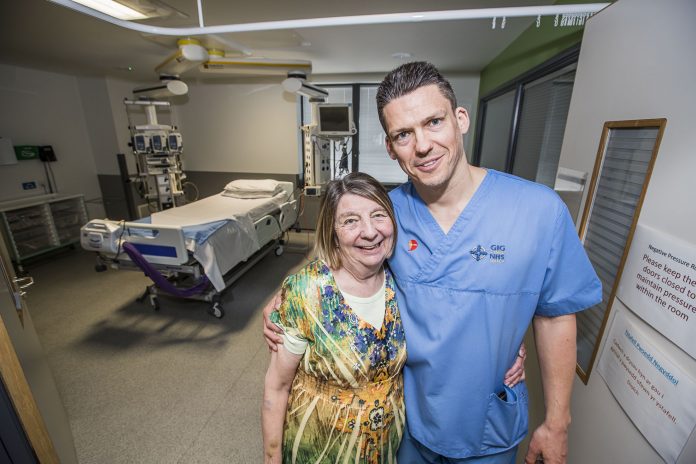
The family of a woman shocked back to life 19 times in one night have thanked hospital staff for saving her life.

Carol Cooper’s heart was re-started with a defibrillator after suffering a series of cardiac attacks as she was being treated in the intensive care unit of Ysbyty Glan Clwyd in Bodelwyddan.
The 70-year-old had been admitted days earlier after collapsing at her home in Bodelwyddan, just a mile from the hospital.
Her family have praised medical staff who cared for the mum-of-four during her stay at the hospital, and for the way in which her treatment was explained in clear terms to them, following new guidelines on how critically ill patients are treated in North Wales hospitals.
The critical care guidelines, drawn up by North Wales Critical Care and Trauma Network with Betsi Cadwaladr University Health Board (BCUHB), have also been shared with health boards across Wales so the same approach to critical care can be followed at other acute hospitals.
Carol’s daughter Lyn said: “We have nothing but praise for the way that Mum was treated, right from the point when Dad dialled 999 through to the day she left hospital three weeks later. Everybody, from the cleaner who made us a cup of tea through to the porters, receptionists, doctors and nurses, showed the highest possible standard of care.
“What was important to us was the way in they explained what was happening and why, during what was a very distressing time for the whole family. Understanding the treatment and the reasons why she was admitted to intensive care helped me to stay calm and I’m sure it is the same for other relatives of those admitted in an emergency.”
The retired hotel worker had previously been treated for a heart attack and had a stent fitted at the Cardiac Centre in Ysbyty Glan Clwyd. The latest illness was due to scarring on her heart muscles, which caused an abnormal heart rhythm or ventricular fibrillation, explained Lyn.
“My dad Mike found her slumped in a chair in the living room, and he immediately phoned for an ambulance – within six minutes there were two paramedic crews there to resuscitate her. She was taken straight to A&E and then to the Percutaneous Coronary Intervention (PCI) lab, as initially it was thought there was a problem with her stent. We were extremely grateful to the staff in the Cardiac Centre who stayed long after their shifts had finished to ensure my mum had the treatment she needed.”
The new lab allows consultants treating people who have had a heart attack to immediately take X-rays of the coronary arteries (angiography) and then perform a procedure known as an angioplasty to open any blockages. Previously patients had to be treated in Liverpool or Chester.
Lyn added: “There it was discovered she had scarring on the heart and was transferred to intensive care. Mum had been unconscious, and very confused on waking, and there was some debate as to how long she had been without oxygen before being discovered by my dad.
“Dr Venkatt was concerned there may be a possibility that my mum had suffered a hypoxic brain injury. We were all appreciative of the calm and compassionate manner in which he explained the issues she was facing.
“A couple of nights later her condition deteriorated and she was put on a ventilator. Then she started to have a series of cardiac arrests, and ended up needing 19 shocks from the defibrillator over the course of the next few hours.
“The unit was very busy, as was A&E, but nothing was too much trouble for the consultant anaesthetist Dr George Bujelli and the specialist ITU nurse Rhys Tudur.”
Carol stayed five nights in ITU – where she marked her 70th birthday – before moving to the hospital’s coronary care unit, and then to Wrexham Maelor Hospital to have a cardiac pacemaker defibrillator fitted before being transferred back to Glan Clwyd to continue her rehab.
Lyn added: “Mum is now up and about and feeling so much better, as the implant ensures her heart rate is kept even, and kick started if anything goes wrong.
“We are now planning a 70th birthday party for her, as she didn’t get to celebrate it properly in hospital.”
The new critical care guidelines specify when a patient is classed as critically ill, and when or how they should be treated in intensive care and high dependency units, where there is more detailed observation, monitoring and treatment than a general ward.
The decision to admit a patient to critical care should be based on the concept of ‘potential benefit’ and based on detailed assessment, say the guidelines.
Doctors and consultants should not be influenced by the patient’s age or disability, when deciding if a patient needs intensive care. They must also take into account the wishes of the patient about the level of care.
For patient safety reasons surgeons and anaesthetists should also check that there is a critical care bed available before starting on planned operations where the patient will need such a high level of care, post-surgery.
The guidelines are now being used throughout the Wales Critical Care & Trauma Network. In North Wales this includes Ysbyty Gwynedd at Bangor, Ysbyty Glan Clwyd at Bodelwyddan, and Wrexham Maelor Hospital.
BCUHB Medical Director and Deputy Chief Executive Dr Evan Moore said: “Critical care is a scarce resource that is often used differently across different health boards. This has led to a lack of clarity amongst referring clinicians about appropriate referrals.
“Members of the Health Board’s Critical Care Delivery Group agreed that a consistent set of guidelines was required for admission and discharge and their adoption is a milestone in the development of BCUHB.
“The guidelines are very clear on how treatment and care should be provided at every stage of a patient’s journey through Critical Care to ensure we get the best possible outcome for them and also their families.
“Importantly, the guidelines are also capable of being adapted and tailored to the needs of individual patients.”
He added: “In drawing them up we consulted with critical care networks in other parts of Wales, drawing on ideas for best practice, and I’m grateful for their assistance.
“Since adopting these guidelines for North Wales we have shared them for all the other health boards in Wales to adapt and use locally.”


























